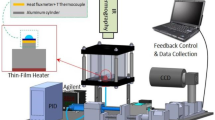Abstract
An evaporation model of a water droplet on a glass substrate is developed to estimate the process time needed to manufacture a liquid crystal display panel (LCD). By using an infrared (IR) lamp as a radiation source to evaporate the droplet, the changes in droplet size and evaporation time are calculated. The peak wavelength of the lamp and initial droplet size are used to estimate the process time. A change in the distribution of droplets is calculated to practically apply the model used in the drying process. By analyzing the contributions of radiation and conduction, we found that the evaporation process is driven by different heat transfer mechanisms according to the peak wavelength of the lamp.
Similar content being viewed by others
References
H. S. Koo et al., Fabrication and chromatic characteristics of the greenish LCD colour-filter layer with nano-particle ink using inkjet printing technique, Displays, 27(3) (2006) 124–129.
K. Song et al., Hybrid compressor model for optical operation of compressed dry air system in LCD production industry, Industrial and Engineering Chemistry Research, 51 (2012) 4998–5002.
D. W. Lee et al., A study on the air knife flow with Coanda effect, Journal of Mechanical Science and Technology, 21(12) (2007) 2214–2220.
S. J. Kowalski and K. Rajewska, Convective drying enhanced with microwave and infrared radiation, Drying Technology, 27(7–8) (2009) 878–887.
R. Dhib, Infrared drying: From process modeling to advanced process control, Drying Technology, 25(1) (2007) 97–105.
T. Lim et al., Evaporation of inkjet printed pico-liter droplet on heated substrates with different thermal conductivity, Journal of Mechanical Science and Technology, 23(7) (2009) 1788–1794.
H. Hu and R. G. Larson, Evaporation of a sessile droplet on a substrate, The Journal of Physical Chemistry B, 106(6) (2002) 1334–1344.
S. K. Varghese and S. Gangamma, Evaporation of water droplets by radiation: Effect of absorbing inclusions, Aerosol and Air Quality Research, 7(1) (2007) 95–105.
S. C. Davis and R. J. Brock, Laser evaporation of droplets, Applied Optics, 26(5) (1987) 786–793.
G. M. Hale and M. R. Querry, Optical constants of water in the 200-nm to 200-μm wavelength region, Applied Optics, 12(3) (1973) 555–563.
V. M. Zolotarev et al., Dispersion and absorption of liquid water in the IR and radio regions of the spectrum, Optics and Spectroscopy, 27 (1969) 430–432.
F. P. Incropera et al., Introduction to heat transfer, Fifth Ed., John Wiley & Sons, USA (2007).
W. M. Irvine and J. B. Pollack, IR optical properties of water and ice spheres, Icarus, 8(1–3) (1968) 324–360.
E. D. Palik, Handbook of optical constants of solids, Academic press, USA (1991).
M. Born and E. Wolf, Principles of optics: Electromagnetics theory of propagation, Interference and Diffraction of Light, Seventh Ed., Pergamon Press, UK (1999).
Author information
Authors and Affiliations
Corresponding author
Additional information
Recommended by Associate Editor Dae Hee Lee
Jinhee Jang received his B.S degree in mechanical engineering and physics from Yonsei University, seoul, Korea in 2010. He is currently study for Unified Master’s and Doctor’s Course in mechanical engineering at Yonsei University.
Changmin Lee received his B.S. degree in mechanical engineering and physics from Yonsei University, seoul, Korea in 2013. He is currently study for Unified Master’s and Doctor’s Course in mechanical engineering at Yonsei University.
Jaewon Hahn received his B.S. degree in Physics from Yonsei University, seoul, Korea in 1981 and M.S and Ph.D. degree from Korea Advanced Institute of Science and Technology in 1983 and 1986, respectively. He is currently a professor at the Department of Mechanical Engineering at Yonsei University in Seoul, Korea. His research interests are the Plasmonic lithography, nanoscope / devices, digital lithography and optical measurement.
Rights and permissions
About this article
Cite this article
Jang, J., Lee, C. & Hahn, J.W. Theoretical study on evaporation of sessile water droplets on a glass panel with infrared radiation. J Mech Sci Technol 28, 1575–1580 (2014). https://doi.org/10.1007/s12206-013-1187-3
Received:
Revised:
Accepted:
Published:
Issue Date:
DOI: https://doi.org/10.1007/s12206-013-1187-3




